History
AN INTRODUCTION TO THE PEOPLE BEHIND THE MUSEUM
The Ross Memorial Museum was a bequest to St. Andrews by Henry and Juliette Ross, American summer residents of the area since 1902 until both passed away within a few days of each other in 1945. The Rosses were knowledgeable collectors who were influenced by early 20th century recognition of American decorative arts and by period restoration projects in Williamsburg and Morristown early in the last century.
THE ROSSES FIRST CAME TO THE ST. ANDREWS AREA TO VISIT COLLEGE FRIENDS…
Staying in Robbinston, Maine, they traveled by boat and carriage to picnic at Chamcook Mountain, saw that the property was for sale and purchased the house and 87 acres of land for $4,500. The house had been designed by architect, H. N. Black, formerly of Boston but practicing in the area after major fires in Saint John and Eastport. In 1909, when Henry retired from the ministry, Rossmont became their permanent home for a few years. In later years the Rosses traveled extensively during the winter or lived in warmer climates. They always returned to Rossmont for many months of the year as they considered it their real home.
HENRY PHIPPS ROSS AND SARAH JULIETTE ROSS AND THEIR DREAM
A friend staying with Henry and Juliette at their estate in Chamcook near St Andrews, described Rossmont like this: “You would love it in this house. No electricity, just beautiful oil (kerosene lamps) and wonderful candle holders all over… Fireplaces all over the place. Five on the first floor and on the second many of them, with one also in the bathrooms. Four immense bedrooms on second floor and we have a beautiful private bath. Downstairs is just grand with rugs and furniture galore….” Louis Pons, 1945. The Rosses were influenced as early collectors by Providence (Rhode Island) leaders in the field such as Charles Pendleton, Luke Vincent Lockwood, Wallace Nutting and Gertrude Tucker. Henry and Juliette lived in Providence from 1905-1907 when Henry was rector of Calvary Church. Charles Pendleton (1846-1904) willed his collection of 18th century American furniture and decorative arts to the Rhode Island School of Design and Pendleton House opened in 1906—becoming the first museum wing dedicated to American decorative arts in the United States. Pendleton was obviously an inspiration to the Rosses when they had the idea to buy Chestnut Hall for their museum.
THE ROSSES AS COLLECTORS…
In 1908 the Rosses were recognized as “true rug lovers” by Rosa Belle Holt, author of Rugs, Oriental and Occidental and the museum has an extensive collection of fine oriental carpets. From 1910-1914 the Rosses formed an excellent collection of early 19th century New Brunswick and American furniture. Later, they traveled extensively and many decorative objects were added to their collection from the trips they took all over the world. While living in California they met and befriended many artists. The work of Mary Curtis Richardson, William Silva and others grace the walls of the museum. Well-known Canadian artist, George Horne Russell, summered in St Andrews and taught Henry Ross to paint. The paintings of both professional—and talented pupil—are on display! Although the museum is not a period restoration, the collection is displayed in a house setting. Everything in the collection was used—and loved by Henry and Juliette.
SARAH JULIETTE ROSS (1868-1945) & HENRY PHIPPS ROSS (1867-1945)
Juliette, as she was known, was born in Detroit to Charles Finney Clark and his wife, Sarah Miranda (née Wilder). Mrs Clark passed away shortly after Juliette’s birth. Mr Clark’s second wife was Ellen M. Fogg of Providence, Rhode Island who was a Mayflower descendant of Richard Warren and Francis Cook. There were two children by this 1870 marriage. The Clark family resided on Madison Avenue in New York City, and at Fairacres, Morristown. Juliette’s half-brother, Charles Martin Clark, succeeded his father as president of the Bradstreet company (now Dun and Bradstreet). Her half-sister, Ella Mabel Clark was a patron of the arts in New York city and Morristown, New Jersey. A diary in the museum collection written by Juliette during her second Grand Tour of Europe, describes her visits to galleries, theatres and cathedrals and contains her views about the sites she visited as a young woman. Henry Phipps Ross was born in Cleveland, Ohio, and was the son of Charles Henry Ross and Josephine (née Phipps) Tyler Ross of Cleveland and Norwich, New York. Josephine had been first married to G. B. Tyler who was killed in the Civil War. Henry was at Harvard for four years and then entered the Episcopal Theological School, graduating in 1895. He was in the ministry until 1909, serving in Taunton, Massachusetts, Providence, Rhode Island and Palo Alto, California. Juliette and Henry were married on 2, 1895 in Morristown. You see them here at Rossmont with some of their many friends later in life.
MORE ON THEIR COLLECTION….
The Rosses were early and enthusiastic collectors. Henry’s passion seems to have been for furniture while Juliette had a particular interest in smaller objets d’art. Henry’s diary shows that they are looking for Chippendale, Sheraton and Hepplewhite furniture. They scoured the local area themselves for their ‘finds’ and also had a man who worked on the estate and traveled as far as Halifax locating pieces for their collection. New Brunswick furniture of the 19th century was not much appreciated until well into the mid-20th century but the Rosses could see and appreciate good design when they saw it. Happily, we now have a very good collection of furniture made by early NB cabinetmaker thanks to them. None of our pieces are labelled but many have been attributed to makers by comparisons made with known examples in other collections as in the case of the sewing stand (76.28) by Thomas Nisbet shown here. Fine American furniture forms part of their collection, as well. Oriental carpets, paintings both Canadian and American, interesting objects from around the world all add to the ambiance of this very personal collection.





